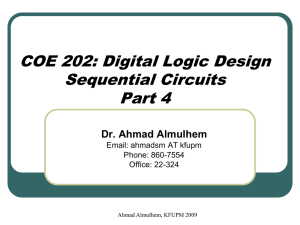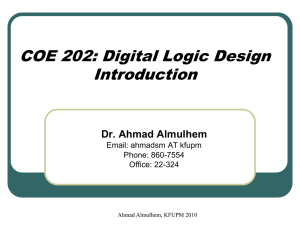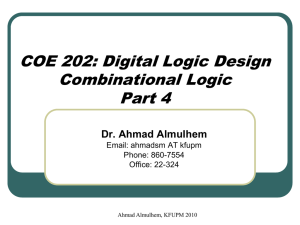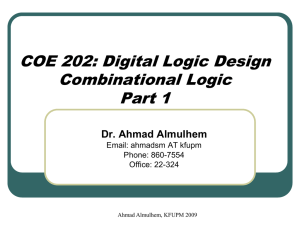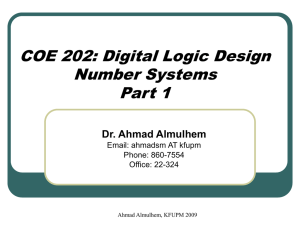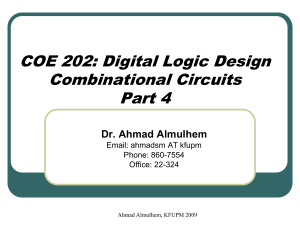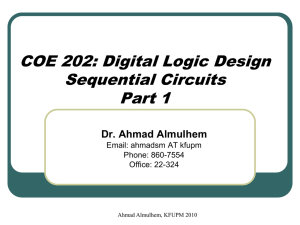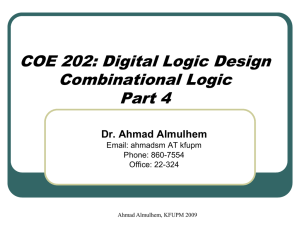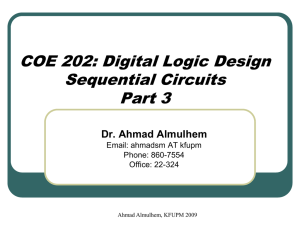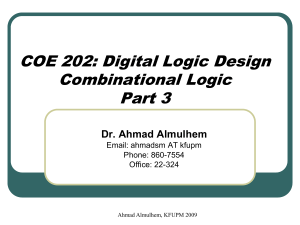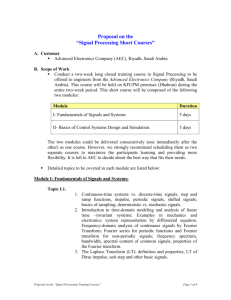ppt
advertisement
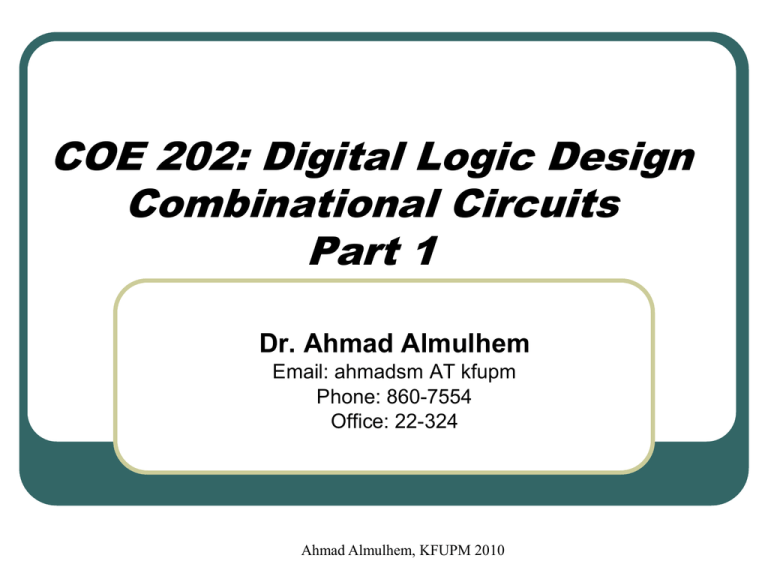
COE 202: Digital Logic Design Combinational Circuits Part 1 Dr. Ahmad Almulhem Email: ahmadsm AT kfupm Phone: 860-7554 Office: 22-324 Ahmad Almulhem, KFUPM 2010 Objectives • Types of Logic Circuits • Combinational • Sequential • Designing Combinational Circuits • Procedure • Examples Ahmad Almulhem, KFUPM 2010 Combinational Circuits • Two classes of logic circuits: • Combinational Circuits • Sequential Circuits • A Combinational circuit consists of logic gates • Output depends only on input • A Sequential circuit consists of logic gates and memory • Output depends on current inputs and previous ones (stored in memory) • Memory defines the state of the circuit. Ahmad Almulhem, KFUPM 2010 Combinational Circuits n inputs Combinational Circuits m outputs A combinational circuit has: • n Boolean inputs (1 or more), • m Boolean outputs (1 or more) • logic gates mapping the inputs to the outputs Ahmad Almulhem, KFUPM 2010 Designing Combinational Circuits • How to design a combinational circuit? • Use all the information and tools you learned • Binary system, Boolean Algebra, K-Maps, etc. • Follow the step-by-step procedure given next Ahmad Almulhem, KFUPM 2010 Design Procedure 1. Specification • • Write a specification for the circuit if one is not already available Specify/Label input and output 2. Formulation • • Derive a truth table or initial Boolean equations that define the required relationships between the inputs and outputs, if not in the specification Apply hierarchical design if appropriate 3. Optimization • • Apply 2-level and multiple-level optimization (Boolean Algebra, K-Map, software) Draw a logic diagram or provide a netlist for the resulting circuit using ANDs, ORs, and inverters Ahmad Almulhem, KFUPM 2010 Design Procedure (Cont.) 4. Technology Mapping • 5. Map the logic diagram or netlist to the implementation technology selected (e.g. map into NANDs) Verification • Verify the correctness of the final design manually or using simulation Practical Considerations: • Cost of gates (Number) • Maximum allowed delay • Fanin/Fanout Ahmad Almulhem, KFUPM 2010 Example 1 Question: Design a circuit that has a 3-bit input and a single output (F) specified as follows: • F = 0, when the input is less than (5)10 • F = 1, otherwise Solution: Step 1 (Specification): • Label the inputs (3 bits) as X, Y, Z • X is the most significant bit, Z is the least significant bit • The output (1 bit) is F: • F = 1 (101)2, (110)2, (111)2 • F = 0 other inputs Ahmad Almulhem, KFUPM 2010 Example 1 (cont.) Question: Design a circuit that has a 3-bit input and a single output (F) specified as follows: • F = 0, when the input is less than (5)10 • F = 1, otherwise Solution: Step 1 (Specification): • Label the inputs (3 bits) as X, Y, Z • X is the most significant bit, Z is the least significant bit • The output (1 bit) is F: • F = 1 (101)2, (110)2, (111)2 • F = 0 other inputs Ahmad Almulhem, KFUPM 2010 Example 1 (cont.) Step 3 (Optimization) Step 2 (Formulation) Obtain Truth table YZ X 0 00 0 01 0 1 0 1 11 0 10 F = XZ + XY 0 1 1 X Y Z F 0 0 0 0 0 0 1 0 0 1 0 0 Circuit Diagram 0 1 1 0 X 1 0 0 0 Z 1 0 1 1 X 1 1 0 1 Y 1 1 1 1 Ahmad Almulhem, KFUPM 2010 F Example 2 Question (BCD to Excess-3 Code Converter) • Code converters convert from one code to another (BCD to Excess-3 in this example) • The inputs are defined by the code that is to be converted (BCD in this example) • The outputs are defined by the converted code (Excess-3 in this example) • Recall Excess-3 code is a decimal digit plus three converted into binary, i.e. 0 is 0011, 1 is 0100, etc. Ahmad Almulhem, KFUPM 2010 Example 2 (cont.) Step 1 (Specification) BCD Input Excess 3 Output Decimal A B C D W X Y Z 0 0 0 0 0 0 0 1 1 1 0 0 0 1 0 1 0 0 2 0 0 1 0 0 1 0 1 3 0 0 1 1 0 1 1 0 Step 2 (Formulation) 4 0 1 0 0 0 1 1 1 Obtain Truth table 5 0 1 0 1 1 0 0 0 6 0 1 1 0 1 0 0 1 7 0 1 1 1 1 0 1 0 8 1 0 0 0 1 0 1 1 9 1 0 0 1 1 1 0 0 X X X X 4-bit BCD input (A,B,C,D) 4-bit E-3 output (W,X,Y,Z) 10-15 All other inputs Ahmad Almulhem, KFUPM 2010 Example 2 (cont.) Step 1 (Specification) BCD Input Excess 3 Output Decimal A B C D W X Y Z 0 0 0 0 0 0 0 1 1 1 0 0 0 1 0 1 0 0 2 0 0 1 0 0 1 0 1 3 0 0 1 1 0 1 1 0 Step 2 (Formulation) 4 0 1 0 0 0 1 1 1 Obtain Truth table 5 0 1 0 1 1 0 0 0 6 0 1 1 0 1 0 0 1 7 0 1 1 1 1 0 1 0 8 1 0 0 0 1 0 1 1 9 1 0 0 1 1 1 0 0 x x x x 4-bit BCD input (A,B,C,D) 4-bit E-3 output (W,X,Y,Z) 10-15 All other inputs Ahmad Almulhem, KFUPM 2010 Example 2 (cont.) Step 3 (Optimization) src: Mano’s book src: online CD Ahmad Almulhem, KFUPM 2010 Example 3 Question (BCD-to-Seven-Segment Decoder) src: Mano’s book • A seven-segment display is digital readout found in electronic devices like clocks, TVs, etc. • • Made of seven light-emitting diodes (LED) segments; each segment is controlled separately. A BCD-to-Seven-Segment decoder is a combinational circuit • • Accepts a decimal digit in BCD (input) Generates appropriate outputs for the segments to display the input decimal digit (output) Ahmad Almulhem, KFUPM 2010 Example 3 (cont.) Step 1 (Specification): • 4 inputs (A, B, C, D) • 7 outputs (a, b, c, d, e, f, g) a b c d e f g BCD-to-SevenSegment Decoder A B C D Ahmad Almulhem, KFUPM 2010 Example 3 (cont.) Step 2 (Formulation) BCD Input 7 Segment Decoder Decimal A B C D a b c d e f g 0 0 0 0 0 1 1 1 1 1 1 0 1 0 0 0 1 0 1 1 0 0 0 0 2 0 0 1 0 1 1 0 1 1 0 1 3 0 0 1 1 1 1 1 1 0 0 1 4 0 1 0 0 0 1 1 0 0 1 1 5 0 1 0 1 1 0 1 1 0 1 1 6 0 1 1 0 1 0 1 1 1 1 1 7 0 1 1 1 1 1 1 0 0 0 0 8 1 0 0 0 1 1 1 1 1 1 1 9 1 0 0 1 1 1 1 0 0 1 1 0 0 0 0 0 0 0 10-15 All Other Inputs Ahmad Almulhem, KFUPM 2010 Invalid BCD codes = No Light Example 3 (cont.) Step 3 (Optimization) a b c e f g Ahmad Almulhem, KFUPM 2010 d Example 3 (cont.) Step 3 (Optimization) (cont.) a = A’C + A’BD + AB’C’ + B’C’D’ b = A’B’ + A’C’D’ + A’CD + B’C’ c = A’B + B’C’ + A’C’ + A’D d = A’CD’ + A’B’C + B’C’D’+AB’C’+A’BC’D e = A’CD’ + B’C’D’ f = A’BC’ + A’C’D’ + A’BD’ + AB’C’ g = A’CD’ + A’B’C + A’BC’ + AB’C’ Exercise: Draw the circuit Ahmad Almulhem, KFUPM 2010 Conclusion • There are two types of logic circuits • Combinational • Sequential • Design Procedure • • • • • Specification * Formulation * Optimization * Technology Mapping Verification • Examples Ahmad Almulhem, KFUPM 2010
